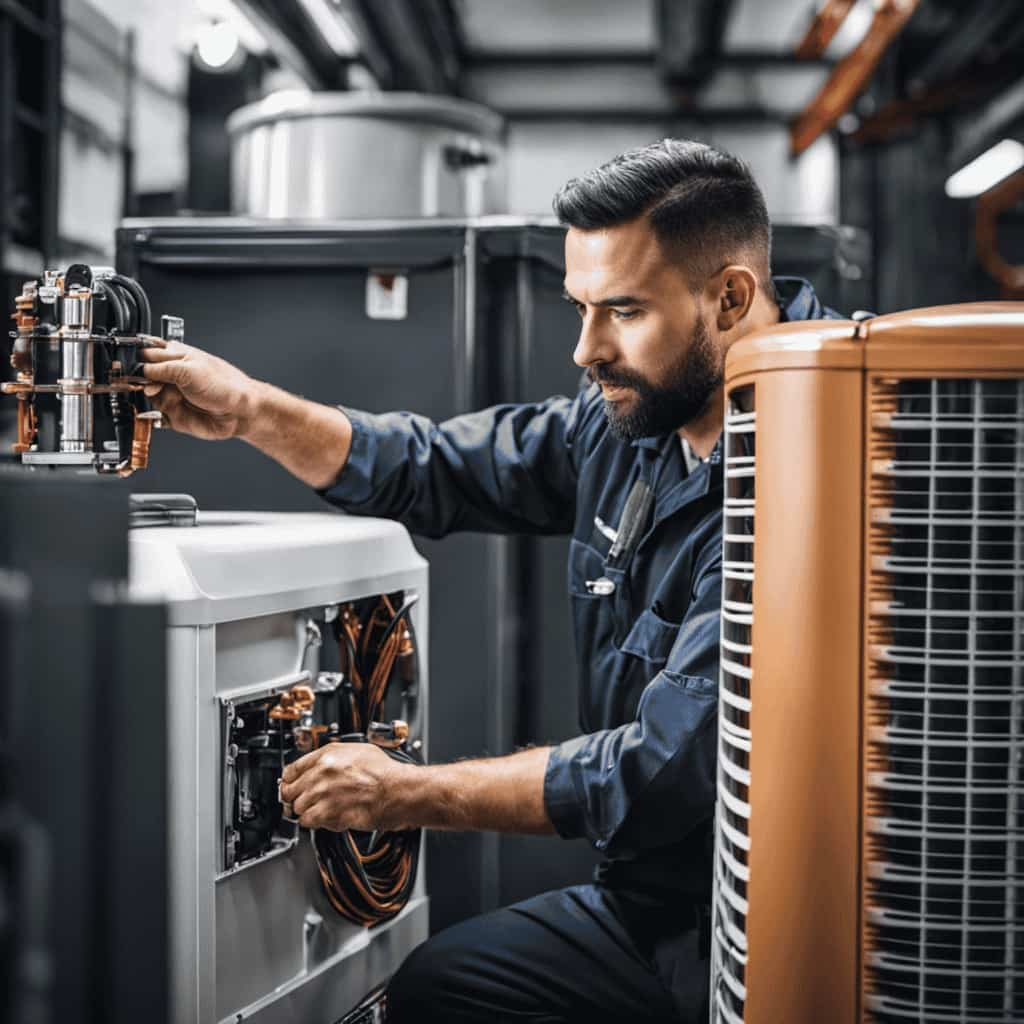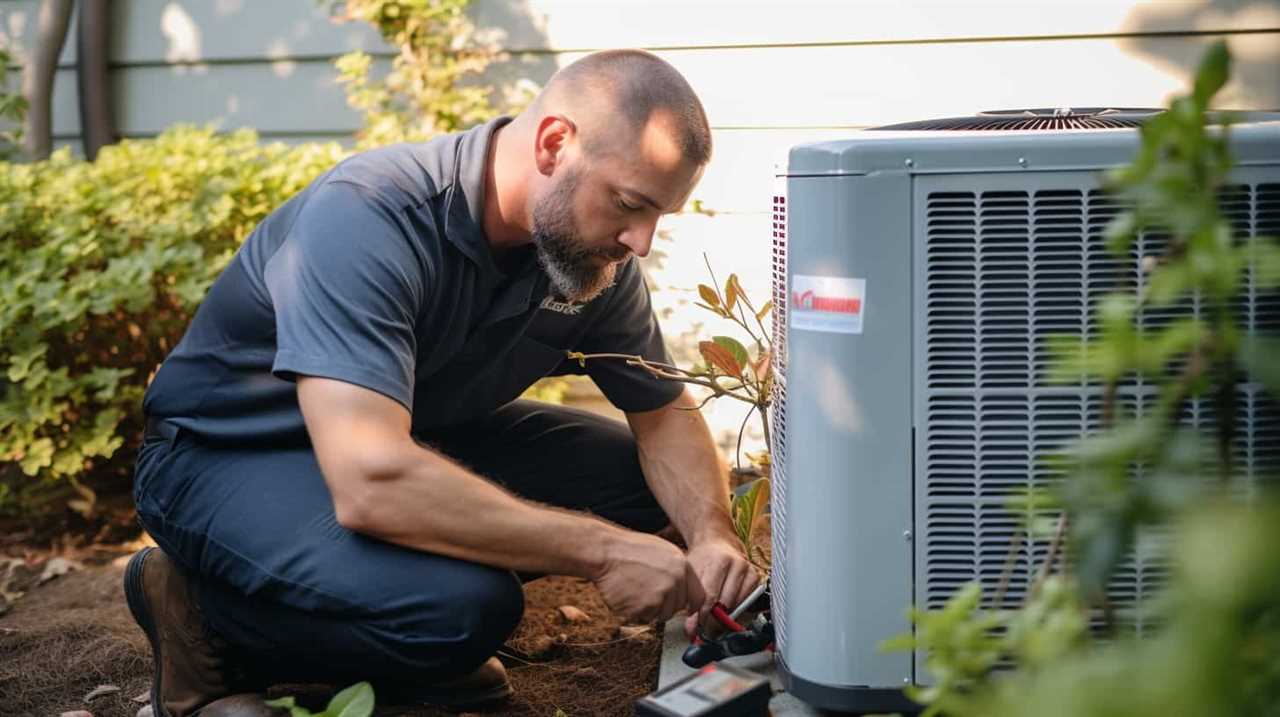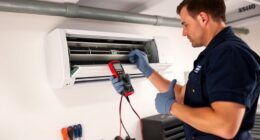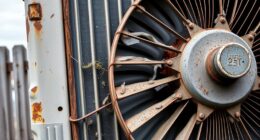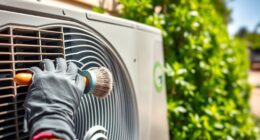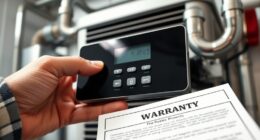We offer the ultimate guide to mastering the installation and maintenance of residential heat pumps.
Get ready to take your expertise to the next level as we break down the basics, share insider tips, and provide step-by-step instructions.
From selecting the right heat pump for your home to maximizing energy efficiency, we’ve got you covered.
Say goodbye to costly repairs and hello to innovation as we dive into the world of residential heat pump mastery.

Key Takeaways
- Residential heat pumps provide both heating and cooling capabilities and transfer heat instead of generating it, resulting in lower energy consumption.
- When selecting and sizing a heat pump, it is important to consider factors such as the size of your home, energy efficiency ratings, and compatibility with your existing HVAC system.
- Proper installation of a heat pump involves positioning the outdoor unit in a suitable location, securely mounting the indoor unit, and ensuring proper connections of refrigerant lines, electrical wiring, and condensate drain.
- To maximize energy efficiency and cost savings, implement energy-efficient practices, use programmable thermostats, ensure proper insulation, consider zoning systems, schedule regular maintenance, and promptly address any issues or troubleshooting needs.
Understanding the Basics of Residential Heat Pumps
We need to understand the basics of a residential heat pump in order to properly install and maintain it.
Residential heat pumps have become increasingly popular due to their numerous benefits and the advantages of heat pump technology. These innovative systems provide both heating and cooling capabilities, making them versatile and efficient.
One of the main benefits of a residential heat pump is its energy efficiency. Unlike traditional heating systems, heat pumps transfer heat rather than generate it, resulting in lower energy consumption and reduced utility bills.
Additionally, heat pumps offer year-round comfort by reversing their operation to provide cooling during hot weather.

Understanding the inner workings of a residential heat pump allows homeowners to make informed decisions when selecting the right heat pump for their home, which we’ll discuss in the subsequent section.
Selecting the Right Heat Pump for Your Home
When choosing a heat pump for your home, it’s important to consider factors such as size, efficiency, and compatibility with your existing HVAC system. Here are some key points to keep in mind:
-
Size: Ensure that the heat pump you select is appropriate for the size of your home. A unit that’s too small will struggle to heat or cool your space effectively, while a unit that’s too large may cycle on and off frequently, leading to inefficiency and increased energy consumption.
-
Efficiency: Look for heat pumps that have high energy efficiency ratings, such as those with ENERGY STAR certification. These units are designed to maximize performance while minimizing energy usage, resulting in lower utility bills and reduced environmental impact.

-
Compatibility: Before making a purchase, check if the heat pump is compatible with your existing HVAC system. This will ensure a seamless integration and prevent any potential issues down the line.
-
Benefits of Heat Pump Technology: Heat pumps offer several advantages, including energy savings, year-round comfort, and improved indoor air quality. By utilizing the heat transfer process, they can extract heat from the air or ground and transfer it indoors during the winter, and vice versa during the summer.
Proper Sizing and Placement of Heat Pumps in Residential Settings
To ensure optimal performance and efficiency, it’s essential to properly size and place heat pumps in residential settings. When it comes to heat pump sizing calculations, it’s crucial to consider factors such as the size of the space being heated or cooled, the climate of the area, and the insulation levels of the building.
These calculations take into account the heat loss or gain of the space to determine the appropriate capacity of the heat pump needed.

Additionally, best practices for heat pump placement involve locating the outdoor unit in a well-ventilated area away from obstructions to ensure proper airflow. It’s also important to consider noise levels and aesthetics when determining the placement of the indoor unit.
Essential Tools and Equipment for Heat Pump Installation
Our essential tools and equipment for heat pump installation include:
-
A set of screwdrivers and wrenches: These tools are used to securely fasten the components of the heat pump system, such as the condenser and evaporator units, to prevent any leaks or loose connections.
-
A multimeter: This device allows us to measure voltage, current, and resistance, ensuring that electrical connections are properly made and functioning correctly.
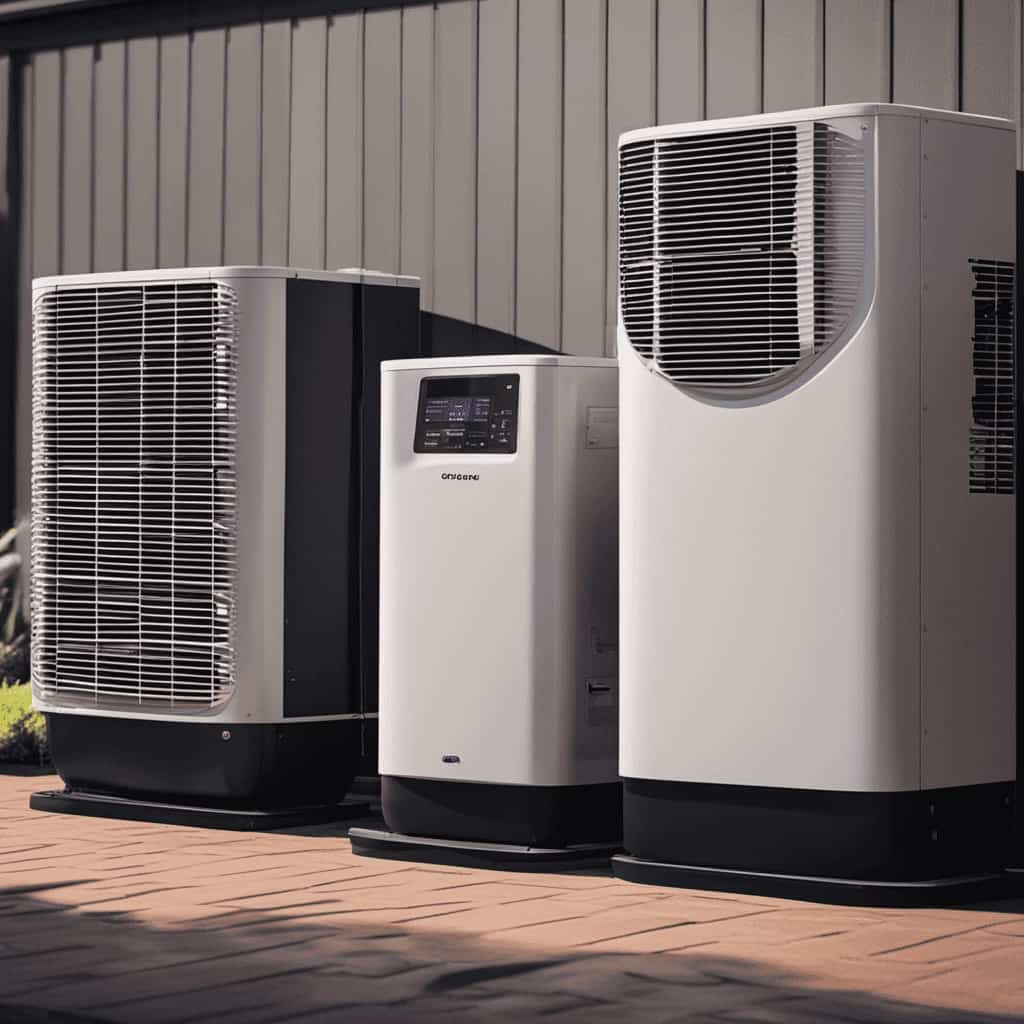
-
Refrigerant gauges: These gauges are used to monitor and regulate the pressure and temperature of the refrigerant during installation, ensuring optimal efficiency and performance.
-
A vacuum pump: This tool is used to evacuate any air and moisture from the refrigerant lines, ensuring a clean and efficient system.
By using these heat pump installation tools and equipment, we can guarantee the highest level of equipment efficiency.
Now, let’s move on to the next section, which provides a step-by-step guide to installing a residential heat pump.
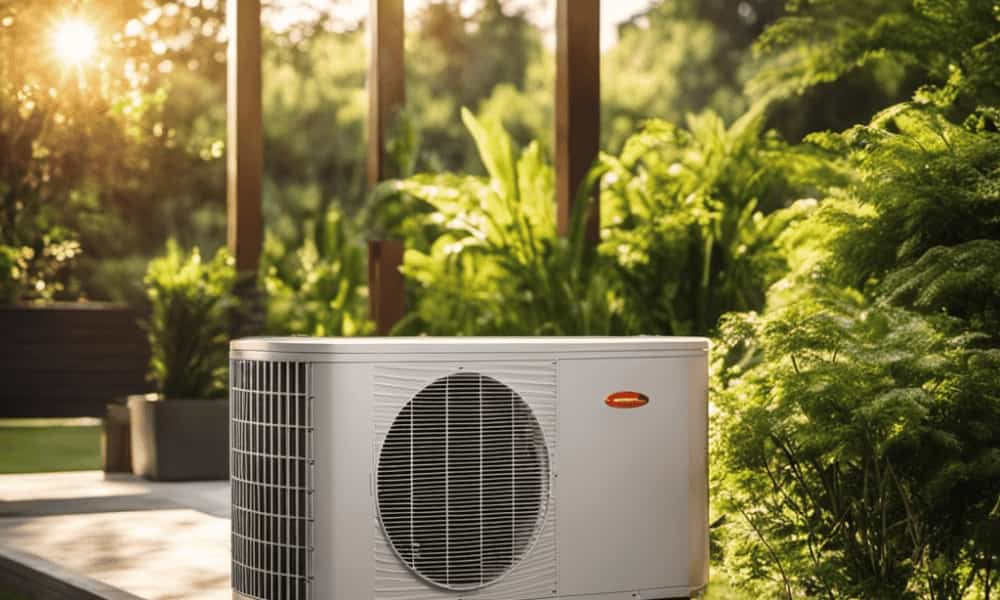
Step-by-Step Guide to Installing a Residential Heat Pump
We will provide a clear and concise step-by-step guide on how to install a residential heat pump.
Installing a heat pump requires a thorough understanding of the system and the necessary tools.
Before starting the installation process, it’s essential to conduct a load calculation to determine the appropriate size of the heat pump for the space.
Once you have the correct size, begin by locating the outdoor unit in a well-ventilated area.

Connect the refrigerant lines, electrical wiring, and condensate drain to the unit.
Next, install the indoor unit, making sure it’s level and securely mounted.
Finally, connect the refrigerant lines, electrical wiring, and condensate drain to the indoor unit.
Once everything is connected, test the system and troubleshoot any issues using best practices and troubleshooting techniques.

Common Maintenance and Troubleshooting Tips for Heat Pumps
Regular maintenance and timely troubleshooting are essential for ensuring optimal performance and longevity of heat pumps. To help you keep your heat pump running smoothly, here are some common maintenance and troubleshooting tips:
-
Regularly clean and replace filters: Clogged filters restrict airflow and reduce efficiency. Clean or replace filters every one to three months, depending on usage.
-
Check outdoor unit: Ensure that the outdoor unit is clear of debris, such as leaves or branches, and that it isn’t blocked by tall grass or vegetation.
-
Inspect the refrigerant levels: Low refrigerant levels can affect the heat pump’s performance. If you notice reduced cooling or heating capacity, contact a professional to inspect and recharge the system.
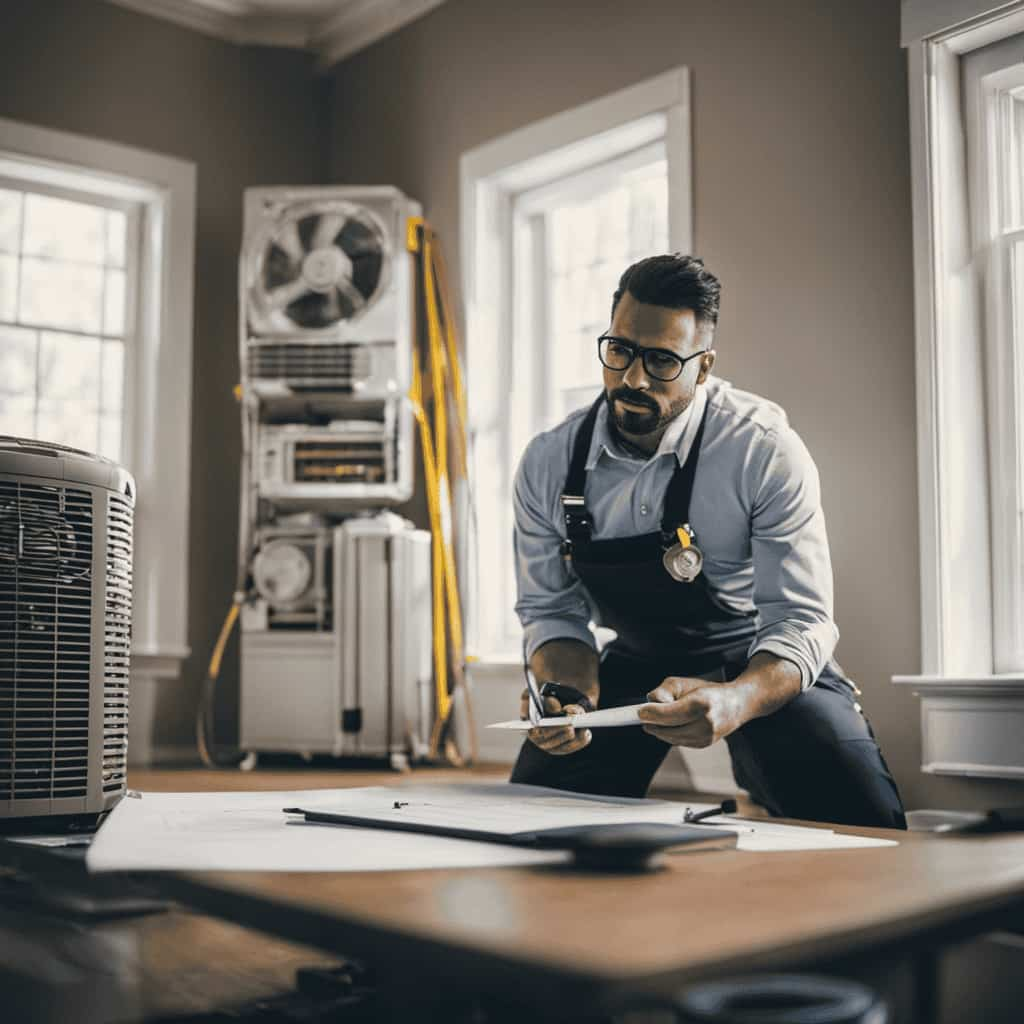
-
Check for strange noises or odors: Unusual noises or smells may indicate a problem with the heat pump. If you encounter any, it’s best to call a qualified technician for further investigation.
Maximizing Energy Efficiency and Cost Savings With Heat Pump Maintenance
To maximize energy efficiency and cost savings, it’s important to perform regular maintenance on your heat pump system. By implementing energy efficient practices and ensuring proper maintenance, you can achieve significant long term cost benefits.
One important maintenance task is to regularly clean or replace the air filters. Clogged filters restrict airflow, reducing the system’s efficiency.
Additionally, regular inspection of the outdoor unit is crucial. Remove any debris, such as leaves or branches, that may obstruct airflow. It’s also recommended to clean the outdoor coil to remove dirt and debris buildup.

Another important aspect of heat pump maintenance is checking the refrigerant levels. Low refrigerant levels can decrease the system’s efficiency and increase energy consumption.
Frequently Asked Questions
How Much Electricity Does a Residential Heat Pump Typically Use?
Residential heat pumps typically use electricity for operation. It’s important to consider their energy efficiency and cost comparison when assessing their overall performance and impact on electricity consumption.
What Are the Common Problems That Can Occur With a Heat Pump System?
Common problems that can occur with a heat pump system include refrigerant leaks, faulty thermostats, and compressor issues. Troubleshooting heat pump issues requires expertise in diagnosing and repairing these technical malfunctions to ensure optimal performance.
How Often Should a Heat Pump Be Serviced or Maintained?
We should regularly service and maintain our heat pump to ensure optimal performance. Signs of malfunction include poor heating/cooling, unusual noises, and increased energy consumption. Proper heat pump maintenance frequency varies based on usage and manufacturer recommendations.
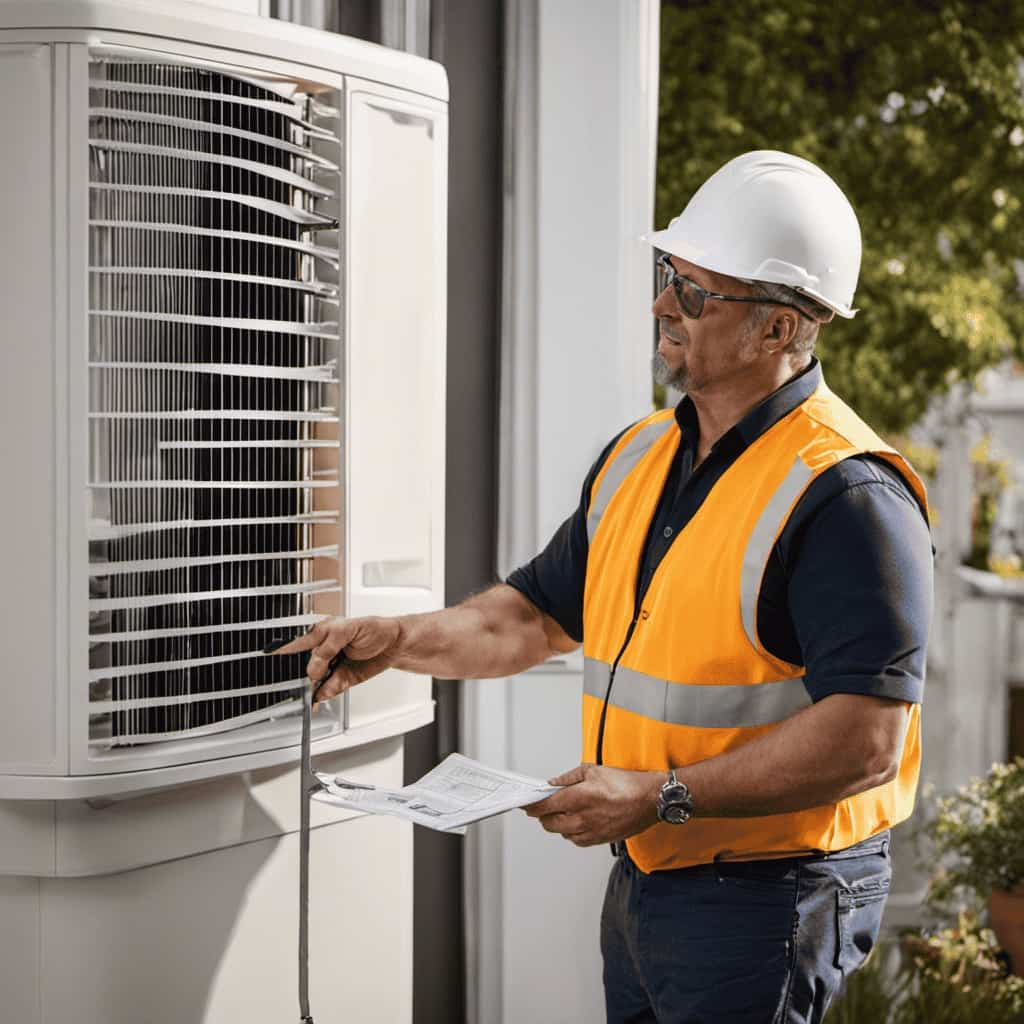
Are There Any Government Incentives or Tax Credits Available for Installing a Residential Heat Pump?
Yes, there are government incentives and tax credits available for installing a residential heat pump. These programs provide financial benefits and can help offset the initial investment, making it more affordable for homeowners.
Can a Heat Pump Be Used for Both Heating and Cooling Purposes in a Residential Setting?
Yes, a heat pump can be used for both heating and cooling purposes in a residential setting. This is advantageous because it maximizes heat pump efficiency and provides year-round comfort and energy savings.
Conclusion
In conclusion, mastering residential heat pump installation and maintenance is crucial for ensuring optimal performance and energy efficiency in your home. By understanding the basics, selecting the right heat pump, proper sizing and placement, and using essential tools and equipment, you can successfully install and maintain a heat pump.
Regular maintenance and troubleshooting can also prevent common issues and maximize its lifespan. For example, a case study showed that by regularly cleaning and replacing air filters, a homeowner increased their heat pump’s efficiency by 15%.
